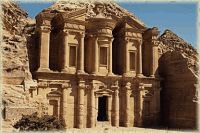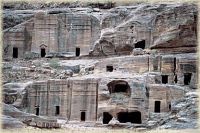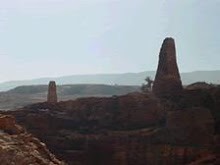Petra is the Greek word for "rock." In the heart of Mount Seir, halfway between the Dead Sea and the Gulf of Aqaba, there is a valley surrounded on all sides by very steep rocky cliffs, with a few narrow gorges leading inside. In this valley, the city of Petra was built. Its Biblical name was Sela. The earliest inhabitants of this area were the Horites, or Hurrians. Later, Esau, the brother of Jacob, settled in the territory south of the Dead Sea, and his descendants, the Edomites, gradually replaced the Hurrians. The Edomites lived here when Israel came from Egypt during the Exodus, about 1445 BC.

About 400 BC, the Edomites were driven out by the Arabian Nabataeans. These people made Petra their capital and controlled the most important trade routes between the East and the West. Caravans passing through this territory had to pay taxes to the Nabataeans, who in this way became very wealthy enabling them to build beautiful palaces, temples, theatres, and tombs hewn out of solid rock in their capital city.

In later centuries, caravans followed other routes between the Orient and Europe. Traffic through Nabataean territory dried up, Petra became deserted and forgotten, and for centuries it was a legendary city. All the references in Scripture were considered by higher critics to be figments of the imagination. They claimed the non-existence of Petra as proof for the unreliability of Scripture.
In the year 1812, the Swiss explorer Johann Burckhardt, disguised as an Arabian sheik, discovered the lost city. When he published his report, it seemed almost unbelievable that such a picturesque place could have existed just 161 kilometres south of Jerusalem without being known.

Because of the unstable Middle Eastern political situation, visits to Petra were made virtually impossible, and only in recent years has this ancient city become readily accessible to tourists. Obadiah describes the lofty places of Petra and the confidence of its inhabitants. However, Jeremiah predicted that the city would lose its power and become uninhabited (Obadiah 3-4; Jeremiah 49:16-18).
Why did God predict the demise of the inhabitants of Petra? For the answer, one must look into the rituals and practices of these people. The main place of worship, the Jabel-Aibb' Atuf, is the best-preserved high place in all the Bible lands. The object of worship here was not God, but the sun. And as part of their worship they offered human sacrifices. Close by, two obelisks may be seen which were probably sun pillars of fertility.

It was because of these and other abominable practices that God instructed Israel on their entry into Canaan after the Exodus, to destroy the high places of the heathen. Because of the pagan vices and immoral rites practised there, the finger of prophecy forecast the downfall and entire destruction of cities like Petra (Read Joel 3:19 and Ezekiel 35:3-9).
Standing on Petra's high place with the colorful ruins of the city below, you can hear the voice of its desolate silence declaring that God's prophetic Word never fails!
Petra and the Bible